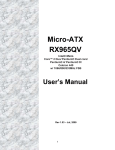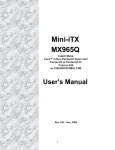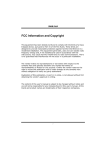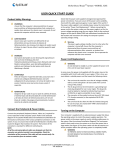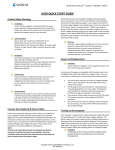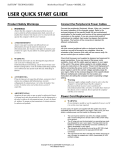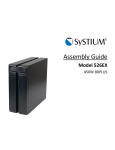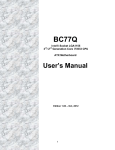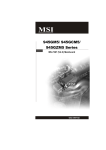Download BCM RX35Q User`s manual
Transcript
Micro-ATX RX35Q Intel® Core™ 2 Quad/ Core™ 2 Duo/ Pentium® 4/ Pentium® D w/ 1333/1000/800MHz FSB User’s Manual First Edition – Jan 2008 1 FCC Statement THIS DEVICE COMPLIES WITH PART 15 FCC RULES. OPERATION IS SUBJECT TO THE FOLLOWING TWO CONDITIONS: (1) THIS DEVICE MAY NOT CAUSE HARMFUL INTERFERENCE. (2) THIS DEVICE MUST ACCEPT ANY INTERFERENCE RECEIVED INCLUDING INTERFERENCE THAT MAY CAUSE UNDESIRED OPERATION. THIS EQUIPMENT HAS BEEN TESTED AND FOUND TO COMPLY WITH THE LIMITS FOR A CLASS "A" DIGITAL DEVICE, PURSUANT TO PART 15 OF THE FCC RULES. THESE LIMITS ARE DESIGNED TO PROVIDE REASONABLE PROTECTION AGAINST HARMFUL INTERFERENCE WHEN THE EQUIPMENT IS OPERATED IN A COMMERCIAL ENVIRONMENT. THIS EQUIPMENT GENERATES, USES, AND CAN RADIATE RADIO FREQUENCY ENERGY AND, IF NOT INSTATLLED AND USED IN ACCORDANCE WITH THE INSTRUCTION MANUAL, MAY CAUSE HARMFUL INTERFERENCE TO RADIO COMMUNICATIONS. OPERATION OF THIS EQUIPMENT IN A RESIDENTIAL AREA IS LIKELY TO CAUSE HARMFUL INTERFERENCE IN WHICH CASE THE USER WILL BE REQUIRED TO CORRECT THE INTERFERENCE AT HIS OWN EXPENSE. Notice This guide is designed for experienced users to setup the system within the shortest time. For detailed information, please always refer to the electronic user's manual. Copyright Notice Copyright © 2008 BCM Advanced Research, ALL RIGHTS RESERVED. No part of this document may be reproduced, copied, translated, or transmitted in any form or by any means, electronic or mechanical, for any purpose, without the prior written permission of the original manufacturer. Trademark Acknowledgement Brand and product names are trademarks or registered trademarks of their respective owners. 2 Disclaimer BCM Advanced Research reserves the right to make changes, without notice, to any product, including circuits and/or software described or contained in this manual in order to improve design and/or performance. BCM Advanced Research assumes no responsibility or liability for the use of the described product(s), conveys no license or title under any patent, copyright, or masks work rights to these products, and makes no representations or warranties that these products are free from patent, copyright, or mask work right infringement, unless otherwise specified. Applications that are described in this manual are for illustration purposes only. BCM Advanced Research makes no representation or warranty that such application will be suitable for the specified use without further testing or modification. Life Support Policy BCM Advanced Research PRODUCTS ARE NOT FOR USE AS CRITICAL COMPONENTS IN LIFE SUPPORT DEVICES OR SYSTEMS WITHOUT THE PRIOR WRITTEN APPROVAL OF BCM Advanced Research. As used herein: 1. Life support devices or systems are devices or systems which, (a) are intended for surgical implant into body, or (b) support or sustain life and whose failure to perform, when properly used in accordance with instructions for use provided in the labeling, can be reasonably expected to result in significant injury to the user. 2. A critical component is any component of a life support device or system whose failure to perform can be reasonably expected to cause the failure of the life support device or system, or to affect its safety or effectiveness. A Message to the Customer BCM Customer Services Each and every BCM product is built to the most exacting specifications to ensure reliable performance in the harsh and demanding conditions typical of industrial environments. Whether your new BCM device is destined for the laboratory or the factory floor, you can be assured that your product will provide the reliability and ease of operation for which the name BCM has come to be known. Your satisfaction is our primary concern. Here is a guide to BCM customer services. To ensure you get the full benefit of our services, please follow the instructions below carefully. 3 Technical Support We want you to get the maximum performance from your products. So if you run into technical difficulties, we are here to help. For the most frequently asked questions, you can easily find answers in your product documentation. These answers are normally a lot more detailed than the ones we can give over the phone. So please consult the user’s manual first. To receive the latest version of the user’s manual; please visit our Web site at: http://www.bcmcom.com. If you still cannot find the answer, gather all the information or questions that apply to your problem, and with the product close at hand, call your dealer. Our dealers are well trained and ready to give you the support you need to get the most from your BCM products. In fact, most problems reported are minor and are able to be easily solved over the phone. In addition, free technical support is available from BCM engineers every business day. We are always ready to give advice on application requirements or specific information on the installation and operation of any of our products. Please do not hesitate to call or e-mail us. BCM Advanced Research 7 Marconi, Irvine, California, 92618 USA Tel : +1-949-470-1888 Fax : +1-949-470-0971 http://www.bcmcom.com E-mail: [email protected] Product Warranty BCM warrants to you, the original purchaser, that each of its products will be free from defects in materials and workmanship for two years from the date of purchase. This warranty does not apply to any products which have been repaired or altered by persons other than repair personnel authorized by BCM, or which have been subject to misuse, abuse, accident or improper installation. BCM assumes no liability under the terms of this warranty as a consequence of such events. Because of BCM high quality-control standards and rigorous testing, most of our customers never need to use our repair service. If any of BCM products is defective, it will be repaired or replaced at no charge 4 during the warranty period. For out-of-warranty repairs, you will be billed according to the cost of replacement materials, service time, and freight. Please consult your dealer for more details. If you think you have a defective product, follow these steps: 1. Collect all the information about the problem encountered. (For example, CPU type and speed, BCM products model name, hardware & BIOS revision number, other hardware and software used, etc.) Note anything abnormal and list any on-screen messages you get when the problem occurs. 2. Call your dealer and describe the problem. Please have your manual, product, and any helpful information available. 3. If your product is diagnosed as defective, obtain an RMA (return material authorization) number from your dealer. This allows us to process your good return more quickly. 4. Carefully pack the defective product, a complete Repair and Replacement Order Card and a photocopy proof of purchase date (such as your sales receipt) in a shippable container. A product returned without proof of the purchase date is not eligible for warranty service. Write the RMA number visibly on the outside of the package and ship it prepaid to your dealer. Manual Objectives This manual describes in detail the BCM RX35Q Main board. We strongly recommend that you study this manual carefully before attempting to interface with RX35Q or change the standard configurations. Whilst all the necessary information is available in this manual we would recommend that unless you are confident, you contact your supplier for guidance. Please be aware that it is possible to create configurations within the CMOS RAM that make booting impossible. If this should happen, clear the CMOS settings, (see the description of the Jumper Settings for details). If you have any suggestions or find any errors concerning this manual and want to inform us of these, please contact our Customer Service department with the relevant details. 5 Safety Precautions Warning! Always completely disconnect the power cord from your chassis whenever you work with the hardware. Do not make connections while the power is on. Sensitive electronic components can be damaged by sudden power surges. Only experienced electronics personnel should open the PC chassis. Caution! Always ground yourself to remove any static charge before touching the mainboard. Modern electronic devices are very sensitive to static electric charges. As a safety precaution, use a grounding wrist strap at all times. Place all electronic components in a static-dissipative surface or static-shielded bag when they are not in the chassis. Document Amendment History Revision st 1 Date By Jan., 2008 W.H. Comment Initial Release 6 Contents Chapter 1: System Setup ..............................................................................................11 1.1 Welcome! ......................................................................................................................................11 1.2 Packing Contents..........................................................................................................................11 1.3 Special Features ...........................................................................................................................12 1.3.1 Product Highlights.........................................................................................................................12 1.4 Before you proceed.......................................................................................................................14 1.5 Mainboard Overview .....................................................................................................................15 1.5.1 Placement direction ......................................................................................................................15 1.5.2 Screw Holes ..................................................................................................................................15 1.5.3 Mainboard Layout .........................................................................................................................16 1.6 Central Processing Unit (CPU) .....................................................................................................17 1.6.1 Installing the CPU .........................................................................................................................18 1.6.2 Installing the CPU Heatsink and fan .............................................................................................20 1.6.3 Uninstalling the CPU Heatsink and fan.........................................................................................22 1.7 System Memroy ............................................................................................................................24 1.7.1 1.7.2 Overview .....................................................................................................................................24 Dual-Channel Mode Population Rule .....................................................................................24 1.7.3 Installing DIMM .............................................................................................................................25 1.7.4 Removing a DIMM ...................................................................................................26 1.8 Power Supply ................................................................................................................................27 1.8.1 ATX 24-pin Power Connector: JPWR3.........................................................................................27 1.8.2 ATX 12V Power Connector: JPW1 ...............................................................................................27 1.9 Back Panel ....................................................................................................................................29 1.10 Connectors/Headers .....................................................................................................................31 1.10.1 Floppy Disk Drive Connector: FDD1.............................................................................................31 1.10.2 IDE Connector: IDE1 ....................................................................................................................31 1.10.3 Serial ATA Connectors: SATA1, SATA3, SATA4, SATA5, SATA2 ..............................................32 1.10.4 Fan Power Connector: CPUFAN1, SYSFAN1..............................................................................32 1.10.5 Chassis Intrusion Switch Header: JCI1 ........................................................................................33 1.10.6 CD-In Connector: JCD_IN1 ..........................................................................................................33 1.10.7 Front Panel Audio Connector: JAUD1....................................................................................33 1.10.8 Front USB Connectors: JUSB1, JUSB2, JUSB3 ..........................................................................34 1.10.9 Serial Port Connector: JCOM1 .....................................................................................................34 7 1.10.10 S/PDIF-Out Connector: JSPD1.....................................................................................................35 1.10.11 IEEE1394 Connector: J1394_1 ....................................................................................................35 1.10.12 Front Panel Connectors: JFP1, JFP2 ...........................................................................................36 1.11 Jumpers ........................................................................................................................................37 1.11.1 Clear CMOS Jumpers: JBAT1 ......................................................................................................37 1.11.2 BIOS Flash Protection: JCI2 .........................................................................................................37 1.11.3 The Header: JSPI1 .......................................................................................................................37 1.12 The Expansion Slots .....................................................................................................................38 1.12.1 Installation of expansion card .......................................................................................................38 1.12.2 Setup an expansion card ..............................................................................................................38 1.12.3 PCI (Peripheral Component Interconnect) Express Slot ..............................................................38 1.12.3.1 PCI-Ex16 Slot: PCI-E3 .............................................................................................................39 1.12.3.2 PCI-E x1 Slot: PCI-E1...................................................................................................................39 1.12.4 PCI Slots: PCI1, PCI2 ...................................................................................................................39 Chapter 2: Starting Up the System .............................................................................40 2.1 Starting Up Your System ...........................................................................................................40 Chapter 3: BIOS Setup ..................................................................................................42 3.1 Introducing BIOS...........................................................................................................................42 3.2 Entering BIOS Setup Menu...........................................................................................................42 3.3 Getting Help ..................................................................................................................................43 3.4 The Main Menu .............................................................................................................................44 3.5 Standard CMOS Features ............................................................................................................46 3.6 Advanced BIOS Features .............................................................................................................49 3.7 3.8 Integrated Peripherals ................................................................................................................53 Power Management Setup ........................................................................................................55 3.9 PnP/PCI Configurations ................................................................................................................58 3.10 H/W Monitor ..................................................................................................................................60 3.11 Frequency/Voltage Control .......................................................................................................61 3.12 Load Fail-Safe/ Optimized Defaults ..............................................................................................63 3.13 BIOS Setting Password ................................................................................................................64 8 Mainboard Specifications Model RX35Q Processor Intel® Core 2 Processor Socket 775 supports Core 2 Quad, Core 2 Duo, Pentium D CPU Supports CPU FSB 800/1066/1333 MHz North Bridge Intel® Q35 Memory DDR2 800/667 SDRAM * Supports DDR2 667 (PC2-5300), DDR2 800 (PC2-6400) memory modules up to 8GB max. (2GB max/ DIMM slot) * DDR2 667MHz recommended for 8GB configuration * 4 DDR2 DIMM slots (240-pin/ 1.8V), supports Non-ECC, un-buffered memory Integrated Graphics Intel® GMA 3100 Engine; up to 256MB can be allocated for GFX South Bridge Intel® ICH9 SATA 4 x SATA II connectors supports 3.0 Gbs transfer speed 1 x SATA II connector from Marvell 88SE6111 PCI-E 1 x PCI-E x 16 slot and 1 x PCI-E x 1 slot PCI 2 x PCI Slots (PCI 2.2 compliant) USB 10 x USB 2.0 ports (4 x Rear I/O, 6 x header) IDE Marvell® 88SE6111 1 x Ultra DMA 66/100/133 IDE controller TPM Infineon® TPM 1 x TPM 1.2 Security Device Super I/O Controller Fintek® F71882FG Floppy Controller 1 x std. floppy controller Serial Ports 2 x RS232 port (1 x Rear I/O, 1 x header) Watch Dog Timer 1 ~ 255 sec timer HW Monitor Yes Audio Realtek® ALC888 HD Audio Codec with auto jack sensing LAN Intel® 82566 1 x 10/100/1000 LAN 1394 VIA® 6308 1 x VIA PCI 1394 controller BIOS AMI® BIOS AMI Bios with 16Mb SPI ROM 9 Expansion Slots PCI-E 1 x PCI-E x 16 Slot supports PCI-E x16 Graphic card or ADD2-DVI card 1 x PCI-E x 1 Slot PCI 2 x PCI slot Onboard I/O Headers IDE 1 x IDE Connector SATA 5 x Std. SATA Connectors *SATA1, SATA3, SATA4, SATA5 through Intel® ICH9 *SATA2 through Marvel® 88SE6111 Floppy 1 x Std. Floppy Header USB 3 x USB Headers (6 ports on headers) 1394 1 x 1394 Header RS232 1 x Header SPDIF 1 x Header CD-IN 1 x Header Front Audio 1 x Header Front Panel 2 x Headers Fan Header 2 x Headers Chassis Intrusion Header 1 x Header LPT Port 1 x Header Back I/O Panel PS/2 Keyboard Mouse 1 x DIN 6 Stack up Connector VGA 1 x DB 15 Connector Serial 1 x DB 9 Connector 1394 and USB 1 x Stack up 1394 and USB Connectors (2 USB ports) LAN and USB 1 x Stack up RJ45 and USB Connectors (2 USB ports) Audio 1 x 6 jacks Audio Connector Power & Connector 1 x Std. 24 pin ATX Connector 1 x 4 pin ATX 12 Connector Form Factor Micro ATX 9.6” x 9.6” 10 Chapter 1: System Setup This chapter describes the motherboard features and the new technologies it supports 1.1 Welcome! The motherboard delivers a host of new features and latest technologies, making it another line of BCM long life motherboards! Before you start installing the motherboard, and hardware devices on it, check the items in your package with the list below. If any of the below items is damaged of missing, please contact your vendor. 1.2 Packing Contents Motherboard z 1 x RX35Q Cable z 1 x Serial ATA Signal Cable z 1 x Floppy Disk Drive Cable z 1 x Ultra DMA 100/66 IDE Cable Accessories z 1 x RX35Q I/O Shield Software CD z 1 x CD contains drivers, user’s manual, and QIG (Quick Installation Guide) Documentation z 1 x Quick Installation Guide 11 1.3 Special Features 1.3.1 Product Highlights Intel® CoreTM 2 Processor Ready This mainboard supports the latest Intel® CoreTM2 processor in the LGA775 package. With the new Intel® CoreTM2 micorarchitecture technology and 1333/1066/800 MHz FSB, Intel® CoreTM2 processor is one of the most powerful and energy efficient CPU in the world. Intel® Q35 Express Chipset The Intel® Q35 Express Chipset provides all business with more effective costs management, safer computing environment, and deploys more responsive PCs. It features the integrated graphics engine, Intel® Graphics Media Accelerator 3100. DDR2 Memory Support The mainboard supports DDR2 memory that features data transfer rates of 800/667MHz to meet the higher bandwidth requirements of the latest 3D graphics, multimedia, and Internet applications. The dual-channel DDR2 architecture doubles the bandwidth of your system memory to boost system performance, and eliminating bottlenecks with peak bandwidths of up to 12.8GB/s. Serial ATA 3.0Gb/s Technology The mainboard supports the Serial ATA (SATA) technology through 4 Serial ATA II interface from Intel® ICH9 chipset. And 1 Serial ATA II interface through Marvell® 88SE6111. The SATA II specification allows for thinner, more flexible cables with lower pin count, reduced voltage requirement (compared to IDE specification), and provides up to 300MB/s data transfer rate. IEEE 1394a Support The IEEE 1394a interface provides high speed digital interface for audio/video appliances such as digital television, digital video camcorders, storage peripherals & other PC portable devices. S/PDIF digital sound ready The mainboard supports the S/PDIF-out (SONY/PHILIPS Digital Interface) function through the S/PDIF interface. It allows to transfer digital audio without converting to analog format and keeps the best signal quality. High Definition Audio The mainboard came with the Realtek ALC888 high-definition audio CODEC that lets you enioy high quality 7.1+2 channel audio without having to buy advanced sound cards. PCI-E x16 support The PCI-E x16 VGA interface specification enhances graphics performance with high bandwidth speeds up to 2.5 Gb/s. 12 USB 2.0 Technology The mainboard implements the Universal Serial Bus (USB) 2.0 specification, dramatically increasing the connection speed from the 12Mbps bandwidth on USB1.1 to a fast 480Mbps on USB2.0. USB2.0 is backward compatible with USB1.1. 13 1.4 Before you proceed Take note of the following precautions before you install motherboard components or change any motherboard settings. • Unplug the power cord from the wall socket before touching any component. • Use a grounded wrist strap or touch a safely grounded object or to a metal object, such as the power supply case, before handling components to avoid damaging them due to static electricity • Hold components by the edges to avoid touching the ICs on them. • Whenever you uninstall any component, place it on a grounded antistatic pad or in the bag that came with the component. • Before you install or remove any component, ensure that the ATX power supply is switched off or the power cord is detached from the power supply. Failure to do so may cause severe damage to the motherboard, peripherals, and/or components. 14 1.5 Mainboard Overview Before you install the mainboard, study the configuration of your chassis to ensure that the motherboard fits into it. Make sure to unplug the power cord before installing or removing the mainboard. Failure to do so can cause you physical injury and damage mainboard components. 1.5.1 Placement direction When installing the mainboard, make sure that you place it into the chassis in the correct orientation. The edge with external port goes to the rear part of the chassis as indicated in the image below. 1.5.2 Screw holes Place the screws into the holes indicated by circles to secure the mainboard to the chassis. Do not over-tighten the screws! Doing so may damage the mainboard. 15 1.5.3 Mainboard Layout 16 1.6 Central Processing Unit (CPU) This mainboard supports Intel® Core 2 Quad, Core 2 Duo, Pentium and Celeron 440 processor in LGA 775 package (with 1333/1000/800MHz FSB only). When you are installing the CPU, make sure to install the cooler to prevent overheating. If you do not have the CPU cooler, consult your dealer before turning on the system. • Your boxed Intel® Core 2 LGA775 processor package should come with installation instructions for the CPU, fan and heatsink assembly. • Upon purchase of the mainboard, make sure that the PnP cap is on the socket and the socket pins are not bent. Contact your retailer immediately if the PnP cap is missing, or if you see any damage to the PnP cap/socket pins/motherboard components. BCM will shoulder the cost of repair only, if the damage is shipment/ transit-related. • Keep the PnP cap after installing the mainboard. BCM will process Return Merchandise Authorization (RMA) requests only if the mainboard comes with the cap on the LGA775 socket. • The product warranty does not cover damage to the socket pins resulting from incorrect CPU installation/removal, or misplacement/loss/incorrect removal of the PnP cap. 1. Overheating: Overheating will seriously damage the CPU and system. Always make sure the cooling fan can work properly to protect the CPU from overheating. Make sure that you apply an even layer of thermal paste between the CPU and the heatsink to enhance heat dissipation. 2. Replacing the CPU: While replacing the CPU, always turn off the ATX power suppply or unplug the power supply’s powr cord from the grounded outlet first to prevent damage to the system and the system. 17 1.6.1 Installing the CPU To install a CPU 1. Locate the CPU socket on the motherboard 2. Press the load lever with your thumb (A) and move it to the left (B) until it is released from the retention tab. To prevent damage to the socket pins, do not remove the PnP cap unless you have installed the CPU. 3. Lift the load lever in the direction of the arrow to a 135° angle 18 4. Lift the load plate with your thumb and forefinger to a 100° angle (A), then push the PnP cap from the load plate window to remove (B). 5. Position the CPU over the socket, making sure the gold triangle is on the bottom-left corner of the socket. The socket alignment key should fit into the CPU notch. 6. Close the load plate (A), then push the load lever (B) until it snaps into the retention tab. The CPU fits in only one correct orientation, DO NOT force the CPU into the socket to prevent damage to the socket pins or CPU. 19 1.6.2 Installing the CPU heatsink and fan The Intel Pentium 4 LGA775 processor requires a specially designed heatsink and fan assembly to ensure optimum thermal condition and performance. • When you buy a boxed Intel® Core 2 processor, the package includes the CPU fan and heatsink assembly. If you buy a CPU separately, make sure that you use only Intel®-certified multi-directional heatsink and fan. • Your Intel® Core 2 LGA775 heatsink and fan assembly comes in a push-pin design and requires no tool to install. • If you purchased a separate CPU heatsink and fan assembly, make sure that you have properly applied Thermal Interface Material to the CPU heatsink or CPU before you install the heatsink and fan assembly. Note: Make sure that you have installed the mainboard to the chassis before you install the CPU fan and heatsink assembly. To install the CPU heatsink and fan: 1. Place the heatsink on top of the installed CPU, making sure that the four fasteners match the holes on the motherboard. Note: Orient the heatsink and fan assembly such that the CPU fan cable is closest to the CPU fan connector. Make sure to orient each fastener with the narrow end of the groove pointing outward. (The photo shows the groove shaded for emphasis.) 20 2. Push down two fasteners at a time in a diagonal sequence to secure the heatsink and fan assembly in place. 3. Connect the CPU fan cable to the connector on the motherboard labeled CPUFAN1. Do not forget to connect the CPU fan connector! Hardware monitoring errors can occur if you fail to plug in this connector. 21 1.6.3 Uninstalling the CPU heatsink and fan. To uninstall the CPU heatsink and fan: 1. Disconnect the CPU fan cable from the connector on the motherboard. 2. Rotate each fastener counterclockwise. 3. Pull up two fasteners at a time in a diagonal sequence to disengage the heatsink and fan assembly from the mainboard. 22 4. Rotate each fastener clockwise to ensure correct orientation when reinstalling. The narrow end of the groove should point outward after resetting. (The photo shows the groove shaded for emphasis.) 23 1.7 System Memory 1.7.1 Overview The mainboard comes with four 240-pin DDR2 Dual Inline Memory Modules (DIMM) sockets. You may use 667MHz (PC2-5300), or 800MHz (PC2-6400); Non-ECC, Un-buffered 1.8V DDR2 memory modules on this board (2GB maximum for each slot). It is recommended to use 667MHz DIMM for 8GB configuration. 1.7.2 Dual-Channel mode Population Rule In Dual-Channel mode, the memory modules can transmit and receive data with two data bus lines simultaneously. Enabling Dual-Channel mode can enhance the system performance. Please refer to the following illustrations for population rules under Dual-Channel mode. • In dual-channel configurations, install only identical (the same type and size) DDR2 memory module pairs for each channel. For instance, DIMM_A1 paired with DIMM_B1, DIMM_A2 paired with DIMM_B2. • Always install DIMMs with the same CAS latency. For optimum compatibility, it is recommended that you obtain memory modules from the same vendor. 24 1.7.3 Installing DIMM Make sure to unplug the power supply before adding or removing DIMMS or other system components. Failure to do so may cause severe damage to both the mainboard and the components. 1. Unlock a DIMM socket by pressing the retaining clips outward. 2. Align a DIMM on the socket such that the notch on the DIMM matches the break on the socket. 3. Firmly insert the DIMM into the socket until the retaining clips snap back in place and the DIMM is properly seated. 1. A DDR2 memory module is keyed with a notch so that it fits in only one direction. 2. DO NOT force the memory module into the socket in order to avoid damaging the memory module and the slot. 25 3. DDR2 memory modules are not interchangeable with DDR and is DDR2 standard is not backward compatible. You shall always install DDR2 memory modules in the DDR2 memory slots. 4. To enable the system boot-up successfully, always inset the memory module into the DMM_A1 slot first. 1.7.4 Removing a DIMM Follow these steps to remove a DIMM. 1. Simultaneously press the retaining clips outward to unlock the DIMM. 2. Remove the DIMM from the socket. 26 1.8 Power Supply 1.8.1 ATX 24-pin Power Connector: JPWR3 This connector connects to an ATX 24-pin connector from power supply unit (PSU). To connect the ATX 24-pin power connector, make sure the 24-pin power connector from PSU is inserted in the proper orientation and the pins are aligned. Then push down the 24-pin power connector firmly into the connector JPWR3. You may use the 20-pin ATX power supply as you like. If you’d like to use the 20-pin ATX power supply, please align the 20-pin power connector from PSU to pin 1 & pin 13 (refer to the color picture below) of JPWR3. There is also a foolproof design on pin 11, 12, 23, & 24 to avoid wrong installation. 1.8.2 ATX 12V Power Connector: JPW1 This 12V power connector JPW1 is used to provide power to the CPU. 27 1. For a fully configured system, we recommend that you use a power supply unit (PSU) that complies with ATX 12 V specification 2.0 ( or later version) and provides a minimum power of 350W. 2. Do not forget to connect the 4-pin JPW1 power plug; otherwise, the system will not boot. 3. Use of a PSU with a higher power output is recommended when configuring a system with more power-consuming devices. The system may become unstable or may not boot if the power is inadequate. 28 1.9 Back Panel • Mouse/Keyboard Connector The standard PS/2 ® mouse/ keyboard DIN connector is for a PS/2® mouse/ keyboard. • USB Port The USB (Universal Serial Bus) port is for attaching USB devices such as keyboard, mouse, or other USB compatible devices. • 1394 Port The 1EEE 1394 port (a.k.a. firewire) provides connection to IEEE 1394 devices. • VGA Port The DB 15-pin female connector is provided for monitor. • LAN (RJ-45) Jack The standard RJ-45 jack is for connection to single Local Area Network (LAN). You can connect to a network cable to it. 29 • Audio Ports These audio connectors are used for audio devices. You can differentiate the color of the audio jacks for different audio sound effects. ▪ Line-In (Blue color): is used for external CD player, tape player or other audio devices. ▪ Line-Out (Green color): is a connector for speaker or headphones. ▪ MIC (Pink color): is a connector for microphone. ▪ RS-Out (Black color): Rear-Surround Out in 4/ 5.1/ 7.1 Channel mode. ▪ CS-Out (Orange color): Center/ Subwoofer Out in 5.1/ 7.1 Channel mode. ▪ SS-Out (Gray color): Side-Surround Out 7.1 Channel mode. 30 1.10 Connectors/ Headers 1.10.1 Floppy Disk Drive Connector: FDD1 This connector supports 360KB, 720KB, 1.2MB, 1.44MB, or 2.88MB floppy disk drive. 1.10.2 IDE Connector: IDE1 (Through Marvell 88SE6111) This connector supports IDE hard disk drives, optical disk drives and other IDE devices. If you install two IDE devices on the same cable, you must configure the drives separately to master/ slave mode by setting jumpers. Refer to IDE device vendor’s documentation for jumper setting instructions. 31 1.10.3 Serial ATA Connectors: SATA1, SATA3, SATA4, SATA5 (Through Intel ICH9) SATA2 (Through Marvell 88SE6111) Please do not fold the Serial ATA cable into 90-degree angle. Otherwise, data loss may occur during transmission. 1.10.4 Fan Power Connectors: CPUFAN1, SYSFAN1 The fan power connectors support system cooling fan with +12V. When connecting the wire to these fan connectors, please note that the red wire is designated as “Power” and should be connected to “+12V” pin; the black wire is designated as “Ground” and should be connected to “GND”. In order to take the advantage of System Hardware Monitor, be sure to use the fan which is specifically designed with speed sensor. Please refer to the recommended CPU fans at processor’s official website or consult the vendor for proper CPU cooling fan. 32 1.10.5 Chassis Intrusion Switch Connector: JCI1 This connector connects to a 2-pin chassis switch. If the chassis is opened, the switch will be short. The system will record this status and show a warning message on the screen. To clear the warning message, you must enter the BIOS and clear the record. 1.10.6 CD-In Connector: JCD_IN1 This connector is provided for external audio input. 1.10.7 Front Panel Audio Connector: JAUD1 This connector allows you to connect the front panel audio and is compliant with Intel® Front Panel I/O Connectivity Design Guide. 33 1.10.8 Front USB Connectors: JUSB1, JUSB2, JUSB3 This connector is compliant with Intel® I/O Connectivity Design Guide, which is ideal for connecting high-speed USB peripherals such as USB HDD, USB digital cameras, USB MP3 players, USB printers, etc. Be sure the pins of VCC and GND is connected to the connector correctly. Otherwise, it may cause damage to the USB port and/or the connected USB device. 1.10.9 Serial Port Connector: JCOM1 This connector is a 16550A high speed communication port that sends/receives 16 byte FIFOs. 34 1.10.10 S/PDIF-Out Connector: JSPD1 This connector is used to connect S/PDIF (Sony & Philips Digital Interconnect Format) interface for digital audio transmission. 1.10.11 IEEE1394 Connector: J1394_1 This connector allows you to connect the IEEE1394 device via an optional IEEE 1394 bracket. 35 1.10.12 Front Panel Connectors: JFP1, JFP2 These connectors are for electrical connections to the front panel switches and LEDs. The JFP1 is compliant with Intel® Front Panel I/O Connectivity Design Guide. 36 1.11 Jumpers 1.11.1 Clear CMOS Jumper: JBAT1 There is a CMOS RAM onboard that has a power supply from an external battery to keep the data of system configuration. For normal state (default), the jumper is set on pin location 1 and 2. To clear the CMOS, set the jumper to pin location 2 and 3 for at least 30 seconds while the system is off. 1. You can clear CMOS by shorting pin 2-3 for at least 30 seconds (while the system is OFF). 1.8 then place the jumper back to pin 1-2 for normal operation. 2. Avoid clearing the CMOS while the system is ON; this will damage the mainboard. 1.11.2 BIOS Flash Protection: JCI2 During the default state (non-protect mode), there is no jumper on all three pins of this header, or it may be placed on pin 2-3. To prevent the BIOS from flash, the jumper can be positioned on pin 1-2. 1.11.3 The Header: JSPI1 This header is prepared for factory use only. 37 1.12 The Expansion Slots In the future, you may need to install expansion cards. The following sub-sections describe the expansion slots and the expansion cards that they support. Make sure to unplug the power cord before adding or removing expansion cards. Failure to do so may cause you physical injury and damage mainrboard components. 1.12.1 Installation of expansion card To install an expansion Card: 1. Before install the expansion card, read the documentation that came with it and make the necessary hardware setting for the card. 2. Remove the chassis cover (if the mainboard is installed in a chassis). 3. Remove the expansion slot bracket from the chassis on the slot that you intend to use. Keep the screw for later use. 4. Align the card connector with the slot and press it firmly until the card is completely seated on the slot. 5. Secure the card to the chassis with the screw that have been removed earlier (in step 3). 6. Place the chassis cover back on. 1.12.2 Setup an expansion card After installing the expansion card, configure it by adjusting the software settings. 1. Turn on the system and change the BIOS settings if necessary. See Chapter 2 for information on BIOS setup. 2. Install the software drivers for the expansion card. 1.12.3 PCI (Peripheral Component Interconnect) Express Slot The PCI Express slot supports the PCI Express interface expansion card. ▪ The PCI Express x16 supports up to 4.0GB/s transfer rate. ▪ The PCI Express x8 supports up to 2.0GB/s transfer rate. ▪ The PCI Express x4 supports up to 1.0GB/s transfer rate. ▪ The PCI Express x1 supports up to 250MB/s transfer rate. 38 1.12.3.1 PCI-E x 16 Slot: PCI-E3 This slot supports PCI-E x16 graphic cards or ADD2-DVI cards. 1.12.3.2 PCI-E x1 Slot: PCI-E1 This slot supports PCI-E x1 cards. 1.12.4 PCI Slots: PCI1, PCI2 The PCI slot supports LAN card, SCSI card, USB card, and other add-on cards that comply with PCI specifications. 1. When adding or removing expansion cards, make sure the system power is OFF. 2. After the card is installed on the system, make the adjustments under system BIOS if necessary, then install the card driver provided by the card vendor under system OS. 3. When using PCI cards on shared slots, ensure that the card driver support “Share IRQ” or the PCI cards do not need IRQ assignments. Otherwise, conflicts will arise between the two PCI groups; marking the system unstable and the card inoperable. 39 Chapter 2: Starting Up the System 2.1 Starting Up Your System 1. After all connections are made, close your computer case cover. 2. Be sure all the switches are off, and check that the power supply input voltage is set to the local voltage, usually in-put voltage is 220V∼240V or 110V∼120V depending on your country’s voltage used. 3. Connect the power supply cord into the power supply located on the back of your system case according to your system user’s manual. 4. Turn on your peripheral as following order: a. Your monitor. b. Other external peripheral (Printer, Scanner, External Modem etc…) c. Your system power. For ATX power supplies, you need to turn on the power supply and press the ATX power switch on the front side of the case. 5. The power LED on the front panel of the system case will light. The LED on the monitor may light up or switch between orange and green after the system is on. If it complies with green standards or if it is has a power standby feature. The system will then run power-on test. While the test are running, the BIOS will alarm beeps or additional message will appear on the screen. If you do not see any thing within 30 seconds from the time you turn on the power. The system may have failed on power-on test. Recheck your jumper settings and connections or call your retailer for assistance. Beep Meaning One short beep when displaying logo No error during POST Long beeps in an endless loop No DRAM install or detected One long beep followed by three short Video card not found or video card memory bad beeps High frequency beeps when system is CPU overheated working System running at a lower frequency 6. During power-on, press <Del> key to enter BIOS setup. Follow the instructions in BIOS SETUP. 7. Power off your computer: You must first exit or shut down your operating system before switch off the power switch. For ATX power supply, you can press ATX power switching after exiting or shutting down your operating system. If you use Windows Operating Systems, click “Start” button, click 40 “Shut down” and then click “Shut down the computer” The power supply should turn off after windows shut down. 41 Chapter 3: BIOS Setup 3.1 Introducing BIOS The BIOS is a program located on a Flash Memory on the motherboard. This program is a bridge between motherboard and operating system. When you start the computer, the BIOS program gains control. The BIOS first operates an auto-diagnostic test called POST (power on self test) for all the necessary hardware, it detects the entire hardware device and configures the parameters of the hardware synchronization. Only when these tasks are completed done it gives up control of the computer to operating system (OS). Since the BIOS is the only channel for hardware and software to communicate, it is the key factor for system stability, and in ensuring that your system performance as its best. In the BIOS Setup main menu of Figure 3-1, you can see several options. We will explain these options step by step in the following pages of this chapter, but let us first see a short description of the function keys you may use here: • Press <Esc> to quit the BIOS Setup. • Press ↑ ↓ ← → (up, down, left, right) to choose, in the main menu, the option you want to confirm or to modify. • Press <F10> when you have completed the setup of BIOS parameters to save these parameters and to exit the BIOS Setup menu. • Press Page Up/Page Down or +/– keys when you want to modify the BIOS parameters for the active option. 3.2 Entering BIOS Setup Menu Power on the computer and by pressing <Del> immediately allows you to enter BIOS Setup Menu. If you are not able to enter the BIOS menu but you still wish to enter Setup, restart the system to try again by turning it OFF then ON or pressing the “RESET” button on the system case. You may also restart by simultaneously pressing <Ctrl>, <Alt> and <Delete> keys. The items under each BIOS category described in this chapter are under continuous update for better system performance. Therefore, the description may be slightly different from the latest BIOS and should be held for reference only. 42 3.3 Getting Help Main Menu The main menu lists the setup functions you can make changes to. You can use the arrow keys to select the item. The on-line description of the highlighted setup function is displayed at the bottom of the screen. Sub- Menu If you find a right pointer symbol (as shown in the picture below) appears to the left of certain fields that means a sub-menu can be launched from this field. A sub-menu contains additional options for a field parameter. You can use arrow keys to highlight the field and press <Enter> to call up the sub-menu. Then you can use the control keys to enter values and move from field to field within a sub-menu. If you want to return to the main menu, just press the <ESC>. General Help <F1> The BIOS setup program provides a General Help screen. You can call up this screen from any menu by simply pressing <F1>. The Help screen lists the appropriate keys to use and the possible selections for the highlighted item. Press <Esc> to exit the Help screen. 43 3.4 The Main Menu • Standard CMOS Features Use this menu for basic system configurations, such as time, date, etc. • Advanced BIOS Features Use this menu to setup the items of AMI® special enhanced features. • Integrated Peripherals Use this menu to specify your settings for integrated peripherals. • Power Management Setup Use this menu to specify your settings for power management. • PnP/PCI Configurations This entry appears if your system supports PnP/PCI. • H/W Monitor This entry shows your PC health status. 44 • Frequency/ Voltage Control Use this menu to specify your settings for frequency/ voltage control and overclocking. • Load Fail-Safe Defaults Use this menu to load the default values set by the BIOS vendor for stable system performance. • Load Optimized Defaults Use this menu to load the default values set by the mainboard manufacturer specifically for optimal performance of the mainboard. • BIOS Setting Password Use this menu to set the password for BIOS. • Save & Exit Setup Save changes to CMOS and exit setup. • Exit Without Saving Abandon all changes and exit setup. 45 3.5 Standard CMOS Features The items in standard CMOS Features Menu include some basic setup items. Use the arrow keys to highlight the item and then use the <PgUp> or <PgDn> keys to select the value you want in each item. • Date (MM:DD:YY) This allows you to set the system to the date that you want (usually the current date). The format is <day> <month> <date> <year>. Day Day of the week, from Sun to Sat, determined by BIOS. Read-only Month The month from Jan. through Dec. Date The date from 1 to 31 can be keyed by numeric function keys. Year The year can be adjusted by users. • Time (HH:MM:SS) This allows you to set the system time that you want (usually the current time). The time format is <hour> <minute> <second>. 46 • SATA1/ 2/ 3/ 4/ 5 Press <Enter> to enter the sub-menu, and the following screen appears: (SATA1, SATA3, SATA4, SATA5 are controlled through Intel ICH9; SATA2 is controlled through Marvell 88SE6111) • Device/ Vendor/ Size It will showing the device information that you connected to the SATA connector. • LBA/ Large Mode This allows you to enable or disable the LBA Mode. Setting to Auto enables LBA mode if the device supports it and the devices is not already formatted with LBA mode disabled. •DAM Mode Select DMA Mode. • Hard Disk S.M.A.R.T. This allows you to activate the S.M.A.R.T. (Self-Monitoring Analysis & Reporting Technology) Capability for the hard disks. S.M.A.R.T. is a utility that monitors your disk status to predict hard disk failure. This gives you an opportunity to move data from a hard disk that is going to fail to a safe place before the hard disk becomes offine. SATA1, SATA3, SATA4, and SATA5 are appearing when you connect the HD devices to the SATA connector on the mainboard. Due to the IDE1 and SATA2 is controlled by Marvell 88SE6111, the BIS will not detect the IDE & SATA device and will not show the status. 47 • Floppy Drive A This item allows you to set the type of floppy drives installed. Available options: [None], [360K, 5.25in.], [1.2M, 5.25in.], [720k, 3.5in.], [1.44M, 3.5in.], [2.88M, 3.5in.]. • System Information Press <Enter> to enter the sub-menu, and the following screen appears: This sub-menu shows the CPU information, BIOS version and memory status of your system (read only). 48 3.6 Advanced BIOS Features • Boot Sector Protection This function protects the BIOS from accidental corruption by unauthorized users or computer viruses. When enabled, the BIOS’s data cannot be changed when attempting to update the BIOS with a Flash utility. To successfully update the BIOS, you’ll need to disable this Flash BIOS Protection function. You should enable this function at all times. The only time when you need to disable it is when you want to update the BIOS. After updating the BIOS, you should immediately re-enable it to protect it against viruses. • Quick Booting Setting the item to [Enabled] allows the system to boot within 10 seconds since it will skip some check items. • Boot Up Num-Lock LED 49 This setting is to set the Num Lock status when the system is powered on. Setting to [On] will turn on the Num Lock key when the system is powered on. Setting to [Off] will allow users to use the arrow keys on the numeric keypad. • IOAPIC Function This field is used to enable or disable the APIC (Advanced Programmable Interrupt Controller). Due to compliance with PC2001 design guide, the system is able to run in APIC mode. Enabling APIC mode will expand available IRQ resources for the system. • MPS Table Version This field allows you to select which MPS (Multi-Processor Specification) version to be used for the operating system. You need to select the MPS version supported by your operating system. To find out which version to use, consult the vendor of your operating system. • CPU Feature Press <Enter> to enter the sub-menu and the following screen appears: • Execute Bit Support Intel’s Execute Bit Support functionality can prevent certain classes of malicious “buffer overflow” attacks when combined with a supporting operating system. This functionality allows the processor to classify areas in memory by where application code can execute and where it cannot. When a malicious worm attempts to insert code in the buffer, the processor disables code execution, preventing damage or worm propagation. • Set Limit CPUID MaxVal to 3 The Max CPUID Value Limit is designed to limit the listed speed of the processor to older operating systems. 50 • Chipset Feature Press <Enter> to enter the sub-menu and the following screen appears: • HPET The HPET (High Precision Event Timers) is a component that is part of the chipset. Enabling this feature will provide you with the means to get to it via the various ACPI methods. • VGA Share Memory The system shares memory to the onboard VGA card. This setting controls the exact memory size shared to the VGA card. • DVMT Mode Select This item allows you to set the mode for the graphics core. [Fixed] mode, a fixed-size fragment of the system memory is allocated to the graphics core. It can only be used by the graphics core. [DVMT] mode, the driver of the graphics core uses the system memory like any other OS component or application does. 51 • Boot Sequence Press <Enter. To enter the sub-menu and the following screen appears: st nd rd • 1 / 2 / 3 Boot Device The items allow you to set the first/ second/ third boot device where BIOS attempts to load the disk operating system. • Boot From Other Device Setting the option to [Yes] allows the system to try to boot from other device. If the system fails to boot st nd rd from the 1 / 2 / 3 boot device. 52 3.7 Integrated Peripherals • USB Controller This setting allows you to enable/ disable the onboard USB controller. • USB Device Legacy Support Select [Enabled] if you need to use a USB-interfaced device in the operating system. • Onboard LAN Controller This item is used to enable/ disable the onboard LAN controller. • LAN Option ROM This item is used to decide whether to invoke the Boot R”OM of the LAN controller. • Onboard IEEE1394 Controller This item allows you to enable/ disable the onboard IEEE 1394 controller. • Extra IDE Controller This setting is used to enable/ disable the onboard IDE controller. • Onboard Audio Controller This setting is used to enable/ disable the onboard audio controller. • On-Chip ATA Devices 53 Press <Enter> to enter the sub-menu and the following screen appears: • PCI IDE BusMaster Set this option to [Enable] to specify that the IDE controller on the PCI local bus has bus mastering capability. • RAID Mode (for ICH9R only, which is optional on RX35Q board) The SATA RAID Mode supports RAID 0, 1, 5, 10. I AHCI is chosen, it allows you to enable SATA Stagger Spinup Support (not RAID mode) and take all hard disks on board as master. • I/O Devices Press <Enter> to enter the sub-menu and the following screen appears: • COM Port 1 This item specifies the base I/O port addresses of the onboar Serial Port 1 (COM1). Selecting [Auto] allows AMIBIOS to automatically determine the correct base I/O address. 54 3.8 Power Management Setup S3-related functions described in this section are available only when your BIOS supports S3 sleep mode. • ACPI Function This item is to activate the ACPI (Advanced Configuration and Power Management Interface) Function. If your operating system is ACPI-aware, such as Windows 2000/XP, select [Enabled]. • ACPI Standby State This item specifies the power saving modes for ACPI function. If your operating system supports ACPI, such as Windows 2000/ XP, you can choose to enter the Standby mode in S1(POS) or S3 (STR) fashion through the setting of this field. Settings are: [S1] The S1 sleep mode is a low power state. In this state, no system context is lost (CPU or chipset) and hardware maintains all system context. [S3] The S3 sleep mode is a lower power state where the in formation of system configuration and open applications/files is saved to main memory that remains powered while most other 55 hardware components turn off to save energy. The information stored in memory will be used to restore the system when a “wake up” event occurs. • Suspend Time Out (Minute) If system activity is not detected for the length of time specified in this field, all devices except CPU will be shut off. • Power Button Function This feature sets the function of the power button. Settings are: [Power Off] The power button functions as normal power off button. [Suspend] When you press the power button, the computer enters the suspend/sleep mode, but if the button is pressed for more than four seconds, the computer is turned off. • Restore On AC Power Loss This item specifies whether your system will reboot after a power failure or interrupt occurs. Settins are: [Off] Always leaves the computer in the power off state. [On] Always leaves the computer in the power on state. [Last State] Restores the system to the status before power failure or interrupt occurred. • Wakeup Event Setup Press <Enter> and the following sub-menu appears: • Resume From S3 By USB Device The item allows the activity of the USB device to wake up the system from S3 (Suspend to RAM) sleep state. • Resume From S3 By PS/2 Keyboard This setting determines whether the system will be awakened from what power saving modes when input signal of the PS/2 keyboard is detected. 56 • Resume From S3 By PS/2 Mouse This setting determines whether the system will be awakened from what power saving modes when input signal of the PS/2 mouse is detected. • Resume By PCI Device (PME#) When set to [Enabled], the feature allows your system to be awakened from the power saving modes through any event on PME (Power Management Event). • Resume By PCI-E Device When set to [Enabled], the feature allows your system to be awakened from the power saving modes through any event on PCI Express device. • Resume By RTC Alarm The field is used to enable or disable the feature of booting up the system on a scheduled time/date. 57 3.9 PnP/PCI Configurations This section describes configuring the PCI bus system and PnP (Plug & Play) feature. PCI, or Peripheral Component Interconnect, is a system which allows I/O devices to operate at speeds nearing the speed the CPU itself uses when communicating with its special components. This section covers some very technical items and it is strongly recommended that only experienced users should make any changes to the default settings. • Primary Graphic’s Adapter This setting specifies which graphics card is your primary graphics adapter. • PCI Latency Timer This item controls how long each PCI device can hold the bus before another takes over. When set to higher values, every PCI device can conduct transactions for a longer time and thus improve the effective PCI bandwidth. For better PCI performance, you should set the item to higher values. • PCI Slot 1/ 2 IRQ These items specify the IRQ line for each PCI slot. 58 • IRQ Resource Setup Press <Enter> to enter the sub-menu and the following screen appears: • IRQ 3/ 4/ 5/ 7/ 9/ 10/ 11/ 14/ 15 These items specify the bus where the specified IRQ line is used. The settings determine if AMI BIOS should remove an IRQ from the pool of available IRQs passed to devices that are configurable by the system BIOS. The available IRQ pool is determined by reading the ESCD NVRAM. If more IRQs must be removed from the IRQ pool, the end user can use these settings to reserve the IRQ by assigning an [Reserved] setting to it. Onboard I/O is configured by AMI BIOS. All IRQs used by onboard I/O are configured as [Available]. If all IRQs are set to [Reserved], and IRQ 14/ 15 are allocated to the onboard PCI IDCE, IRQ 9 will be available for PCI and PnP devices. IRQ (Interrupt Request) lines are system resources allocated to I/O devices. When an I/O device needs to gain attention of the operating system, it signals this by causing an IRQ to occur. After receiving the signal, and when the operating system is ready, the system will interrupt itself and perform the service required by the I/O device. 59 3.10 H/W Monitor • Chassis Intrusion The field enables or disables the feature of recording the chassis intrusion status and issuing a warning message if the chassis is once opened. To clear the warning message, set the field to [Reset]. The setting of the field will automatically return to [Enabled] later. • CPU Smart FAN Target The mainboard provides the Smart Fan function which can control the CPU fan speed automatically depending on the current temperature to keep it within a specific range. You can select a fan target value here. If the current CPU fan temperature reaches to the target value, the smart fan function will be activated. It provides several sections to speed up for cooling down automatically. • SYS FAN1 Control The field allows you to determine the fan speed whether the system fan connected to SYSFAN1 when the system is turned on. • CPU/ System Temperature, CPU FAN/ SYS FAN1 Speed, CPU Vcore, 3.3V, 5V, 12V, 5V SB These items display the current status of all of the monitored hardware devices/ components such as CPU voltage, temperatures and all fans’ speeds. 60 3.11 Frequency/Voltage Control Change these settings only if you are familiar with the chipset. • Current CPU/ DARM Frequency These items show the current clocks of CPU and Memory speed. Read-only. • Intel EIST The Enhanced Intel SpeedStep technology allows you to set the performance level of the microprocessor whether the computer is running on battery or AC power. This field will appear after you installed the CPU which support speedstep technology. • Adjust CPU FSB Frequency This item allows you to select the CPU Front Side Bus clock frequency (in MHz) and overclock the processor by adjusting the FSB clock to a higher frequency. Setting options: For CPU FSB200: [200]~[500] 61 • Adjusted CPU Frequency This item shown the CPU frequency after you adjusted. You need to restart the system to load the new CPU frequency you choose. (read only). 62 3.12 Load Fail-Safe/ Optimized Defaults The two options on the main menu allow users to restore all of the BIOS settings to the default Fail-Safe or Optimized values. The Optimized Defaults are the default values set by the mainboard manufacturer specifically for optimal performance of the mainboard. The Fail-Safe Defaults are the default values set by the BIOS vendor for stable system performance. When you select Load Fail-Safe Defaults, a message as below appears: Selecting OK and pressing <ENTER> loads the BIOS default values for the most stable, minimal system performance. When you select Load Optimized Defaults, a message as below appears: Selecting OK and pressing <ENTER> loads the default factory settings for optimal system performance. 63 3.13 BIOS Setting Password When you select this function, a message as below will appear on the screen: Type the password, up to six characters in length, and press <Enter>. The password typed now will replace any previously set password from CMOS memory. You will be prompted to confirm the password. Retype the password the press <Enter>. You may also press <ESC> to abort the selection and not enter a password. To clear a set password, just press <Enter> when you are prompted to enter the password. A message will show up confirming the password will be disabled. Once the password is disabled, the system will boot and you can enter Setup without entering any password. When a password has been set, you will be prompted to enter it every time you try to enter Setup. This prevents an unauthorized person from changing any part of your system configuration. 64
































































